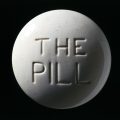In recent years, the medical community has attempted to acknowledge and address issues involving the gender bias found woven throughout the industry. The evolution of this male dominated industry created biases that ultimately flowed through every process, from research and clinical trials to diagnosis and dosing.
Consequently, a variety of practitioners, including: researchers, drug developers, medical schools, and even practicing physicians have asked for a mulligan. As each discipline rethinks their approach and tries to see things through fresh eyes, the goal is to right the wrongs of the past, to recognize the ways women are different from men, and to adjust the system to accommodate those differences.
So, while mea culpa’s are cool and the industry admits that women have been wronged, I humbly submit a request to turn those fresh eyes toward the curiously divergent histories of synthesized sex hormones.
Synthesizing Steroids
Scientists in Germany and Switzerland first began to synthesize the male sex hormone, testosterone, in 1935, and, the lead investigator from each team won the Nobel Prize in Chemistry four years later. Fanfare surrounding their discovery centered on the potential for these new compounds to help elite athletes build muscle power and improve performance. Today, the synthetic compound they created is most commonly referred to as “anabolic steroids.”
Similarly, two different labs synthesized the female sex hormone, estradiol, in 1938. First, a team at Shering Pharmaceuticals in Germany developed ethinylestradiol (EE), and it is widely believed the Nazi’s began feeding it to female prisoners at Auschwitz in their soup as a means of trying to chemically sterilize them. That same year, Sir Charles Dodds developed diethylstilbestrol (DES) and rushed it to market, bypassing the patent process. He hoped the global open access to his version of steroid would deter the Nazis from conducting further tests on prisoners.
Much to his dismay, the unfettered accessibility only inspired drug companies and physicians around the world to find unscrupulously creative ways to play with their new steroid toy. It didn’t take long to discover the many pitfalls of DES (mostly centered around various cancers), and it was ultimately banned. Meanwhile, the Nazi version of synthetic estradiol, EE, survived. In fact, it remains one of the most commonly produced drugs in the world, as it is the estrogenic compound used in every formulation of combination birth control. Interestingly, EE is also an anabolic steroid. However, it is most commonly referred to today using the misnomer, “estrogen.”
Differing Goals
It would be impossible to script a better beginning, if your goal was to highlight how differently the medical establishment treats men and women. From the outset, scientists employed the male sex steroid to try and enhance athletic performance, and the female sex steroid to suppress and control fertility.
Over the decades, use of the male version trickled down from world-class athletes to a younger generation of amateur athletes who wanted to emulate their sports heroes.
Meanwhile, use of the female version flowed upstream beyond attempts to chemically sterilize those labeled as “undesirables” to include pretty much any woman of reproductive age.
As divergent as their stories may be, these two potent steroids do have many similarities. In fact, the consequences and side effects of each proved so alarming that the United States Congress held hearings to look into the safety of each one individually. First, the Nelson Pill Hearings delved into whether hormonal birth control had ever been proven safe in 1970. Then, after passing to the Anabolic Steroids Control Act of 1990, Congress held hearings on the male sex steroid in 2005.
However, this is the most superficial of similarities because neither hearing mentioned any comparison to the other sex steroid. It’s as if the two were no more related than the Congressional hearings on UFOs.
Different Outcomes… Of Course
The 2005 hearing on anabolic steroids featured stories of suicides, aggressive behavior, and heart disease experienced by the young men who took these drugs. It led Congress to ban the steroids in all professional sports. Although the previous legislation had already classified anabolic steroids as a Schedule III drug, which meant it would be strictly controlled, and anyone who continued to distribute or use these drugs to affect their performance faced serious consequences.
The 1970 hearing on “hormonal” birth control featured stories of suicides, aggressive behavior, chronic disease, blood clots, strokes, infertility, and early warning signs that we were about to witness a dramatic rise in breast cancer cases. Congress responded by making birth control the first drug required to include a patient information pamphlet in each box, but failed to implement any further restrictions.
To be fair, most distribution of anabolic steroids was happening on the black market, and they were being administered by non-medical professionals. So, the need to be restrictive was undoubtedly much more obvious than with hormonal birth control, which was being doled out by physicians via prescription.
The irony is that anabolic steroids are pretty well controlled today, while our lack of concern regarding the potency of the steroids in birth control has led to nearly unfettered access to these potent steroids.
It’s almost as if we lifted the poison safely out of the grasp of our sons with our right hand, while spoon-feeding it to our daughters with our left.
At this point, many people would probably still argue that it makes complete sense that anabolic steroids are strictly controlled, while women should maintain the right to unfettered access to EE. That certainly jives with the narrative we have been fed over the past 60 years, but what happens when we dig a little deeper?
Taking Action
The emotional strain of horrific suicides among young men who “had everything going for them” fueled the outcry to protect our sons from the dangers of anabolic steroids, but the problems did not end there. As awareness grew, advocates were able to cite a litany of concerning consequences, including changes in cholesterol levels, increased blood pressure, strokes, liver tumors, shrunken testes, and increased cancer risks.
With all these issues, it’s no wonder they were able to get anabolic steroids banned. At the time of the hearings, it was estimated that 500,000 teenagers across the U.S. had taken illegal steroids. Compare that with a conservative estimate of 18 million women who continue to take hormonal birth control every day.
So, now that we see there is no comparison when it comes to scope, let’s consider whether the risks of anabolic steroids justify such a dramatic clamp down compared to EE.
Side Effects
Suicide & Depression
If…
we strive to protect our young men because “steroids” have been linked to depression as shown in a recent population study, which demonstrated that men taking these drugs are three times more likely to attempt suicide,
Then…
shouldn’t we also protect our young women because large population studies revealed that women who take hormonal birth control are 70% more likely to experience depression and are three times more likely to commit suicide?
Cholesterol & Blood Pressure
If…
we worry about the adverse effect of anabolic steroids on liver metabolism, lipid proteins, and blood pressure,
Then…
shouldn’t we also worry about hormonal birth control’s effect on those same processes?
Dr. Victor Wynn identified birth control’s impact on lipid proteins back in the late 1960’s and labeled it as a kind of “chemical diabetes.”
Yet, over the following decades, we made hormonal birth control such an accepted and expected part of a woman’s routine that a paper in 2005 (the same year Congress was putting the hammer down on anabolic steroids) recommended stopping birth control as an intervention for lowering blood pressure.
Let that settle in – hormonal birth control has become so ubiquitous that researchers actually suggested that stopping it could be an effective treatment for high blood pressure!
Strokes & Cardiac Events
If…
a few case studies that suggest an increase in strokes and cardiac events among young men who take anabolic steroids alarm us,
Then…
shouldn’t we also be alarmed that a meta analysis of several studies found that hormonal birth control of any dose posed a significantly increased risk of ischemic stroke? Overall, women who took birth control with EE were over two-and-a-half times more likely to suffer a stroke.
Other studies demonstrated that women taking hormonal birth control carry twice the risk of having a cardiac event compared to non-users.
Liver Tumors
If…
we recognize that the liver is a hormone-sensitive organ, and lament anabolic steroids’ effect on it as such, particularly when it comes to hepatic adenomas,
Then…
we surely should warn women that the same concern regarding liver adenomas is only growing more prevalent with the newer generation of hormonal birth control, and the risk increases with the duration of use. A study from the Armed Forces Institute of Pathology found that women who take hormonal birth control for 109 months or more face a 250-fold increase in developing liver adenomas.
Shrunken Testes (Ovaries)
If…
we are concerned about a young man’s future fertility and what effect shrunken testes from anabolic steroids might have on him,
Then…
why are so few young women told about the news that EE shrinks their ovaries? Why are we also covering up that these drugs create several layers of problems that could contribute to infertility, such as endometriosis?
Pages of results from modern search engines would leave us with the impression that shrunken testes from steroids could have dire consequences for a young man’s future fertility, while the same side effect on a woman’s ovaries from birth control will have no impact on her ability to have children in the future. It makes no sense.
And, the reason it makes no sense is that it simply is not true!
Dr. M. James Whitelaw published a paper in the Journal of the American Medical Association (JAMA) in 1966 describing atrophy that was occurring in the reproductive systems of women who were taking hormonal birth control. He explained, “Any part of the body which is not used, or little used, over a protracted period leads to so-called ‘disuse atrophy.’” He labeled the atrophy of the ovaries and the lining of the uterus as “oversuppression syndrome,” and estimated that it had already contributed to a 10 percent increase in the rate of infertility. Again, this was in 1966!
Dr. Whitelaw’s research generated a lot of buzz when he presented his findings to Congress at the Nelson Pill Hearings in 1970. But, after that, the PR machine for the drug companies kicked into high gear and made sure the only thing being more suppressed than the human uterus was Dr. Whitelaw’s findings.
Increased Cancer Risk
If…
we eagerly tell men that anabolic steroids contribute to higher levels of prostrate cancer,
Then…
should we not also be blaring the horns to tell women about the shocking 400% rise in breast cancer cases over the past 60 years that is absolutely, unequivocally due to the mass distribution of hormonal birth control?
Perhaps we could even start warning them about its link to rises in cervical cancer – doubling their risk after ten years of use, or we could even share with them that some studies have shown that the steroids in birth control could triple your risk of developing skin cancer.
How Do We Get It Under Control?
Whether they are called anabolic steroids or wrongly called “estrogen” — whether they mimic male or female sex hormones, the chemicals in these potent compounds can have very profound and unwelcome effects on the human body. The two share much more in common than their histories would suggest.
Consequently, we live in a world where a doctor could have two patients – the first, a young man using anabolic steroids; and the other, a young woman using hormonal birth control – both patients could tell the doctor that they suffer from depression and just want to end it all.
It is entirely feasible that this doctor would warn the young man of the dangers of anabolic steroids and do everything in his power to help the young man stop using them. Then, that very same doctor could walk into the next exam room and tell the young woman that her feelings are perfectly normal. She just needs to give her body time to adjust to The Pill.
And that, ladies and gentlemen, is what we call gender bias!
It is time to reconsider the messages surrounding these two drugs. Anabolic steroids sit alongside drugs containing codeine, sharing their Schedule III status. This clearly sends the message that these drugs are powerful – that they carry serious consequences and are not to be taken lightly.
Meanwhile, with the recent introduction of an over-the-counter version, the message surrounding hormonal birth control is that it is a safe as aspirin, or perhaps safer. Many doctors tell women that the “hormones” in birth control are just like the hormones their bodies produce, giving the impression that The Pill is essentially a supplement.
I can think of no better way to right the wrongs of the past than to blaze a new trail and get these two very similar drugs traveling down the same path – one where patients, regardless of gender, are informed about the drawbacks of their respective drugs; one where doctors don’t trivialize serious side effects; one where none of these powerful drugs can be picked up on a street corner without a prescription.
We Need Your Help
More people than ever are reading Hormones Matter, a testament to the need for independent voices in health and medicine. We are not funded and accept limited advertising. Unlike many health sites, we don’t force you to purchase a subscription. We believe health information should be open to all. If you read Hormones Matter and like it, please help support it. Contribute now.
Yes, I would like to support Hormones Matter.
Image by Peggy und Marco Lachmann-Anke from Pixabay.
This article was published originally on July 16, 2024.
















Thank you Mike, great informative article and support of women!.
Having never taken any type of birth control pill, I was totally unaware of
the many issues, especially when compared to anabolic steroids. I never
knew all of the negative side effects of birth control pills. How sad that
women are usually disregarded compared to how men are treated.